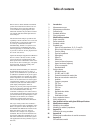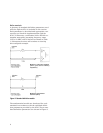
10
It is not possible to remove fringing capacitance,
but the resultant phase shift can be modeled as a
function of frequency using C
0
through C
3
(C
0
+C
l
ϫ f + C
2
ϫ f
2
+ C
3
ϫ f
3
,with units of F(Hz), C
0
(fF),
C
1
(10
-27
F/Hz), C
2
(10
-36
F/Hz
2
) and C
3
(10
-45
F/Hz
3
),
which are the coefficients for a cubic polynomial
that best fits the actual capacitance of the “open.”
A number of methods can be used to determine the
fringing capacitance of an “open.” Three tech-
niques, described here, involve a calibrated reflec-
tion coefficient measurement of an open standard
and subsequent calculation of the effective capaci-
tance. The value of fringing capacitance can be cal-
culated from the measured phase or reactance as a
function of frequency as follows.
C
eff
– effective capacitance
∆∅ – measured phase shift
f – measurement frequency
F – farad
Z
0
– characteristic impedance
X – measured reactance
This equation assumes a zero-length open. When
using an offset open the offset delay must be
backed-out of the measured phase shift to obtain
good C
0
through C
3
coefficients.
This capacitance can then be modeled by choosing
coefficients to best fit the measured response
when measured by either method 3 or 4 below.
1. Fully calibrated 1-Port–Establish a calibrated
reference plane using three independent standards
(that is, 2 sets of banded offset shorts and load).
Measure the phase response of the open and solve
for the capacitance function.
2. TRL 2-PORT–When transmission lines standards
are available, this method can be used for a com-
plete 2-port calibration. With error-correction
applied the capacitance of the open can be meas-
ured directly.
3. Gating–Use time domain gating to correct the
measured response of the open by isolating the
reflection due to the open from the source match
reflection and signal path leakage (directivity).
Figure 3 shows the time domain response of the
open at the end of an airline. Measure the gated
phase response of the open at the end of an airline
and again solve for the capacitance function.
tan( )
∆∅
2
2πfZ
0
1
2πfX
C
eff
==


















